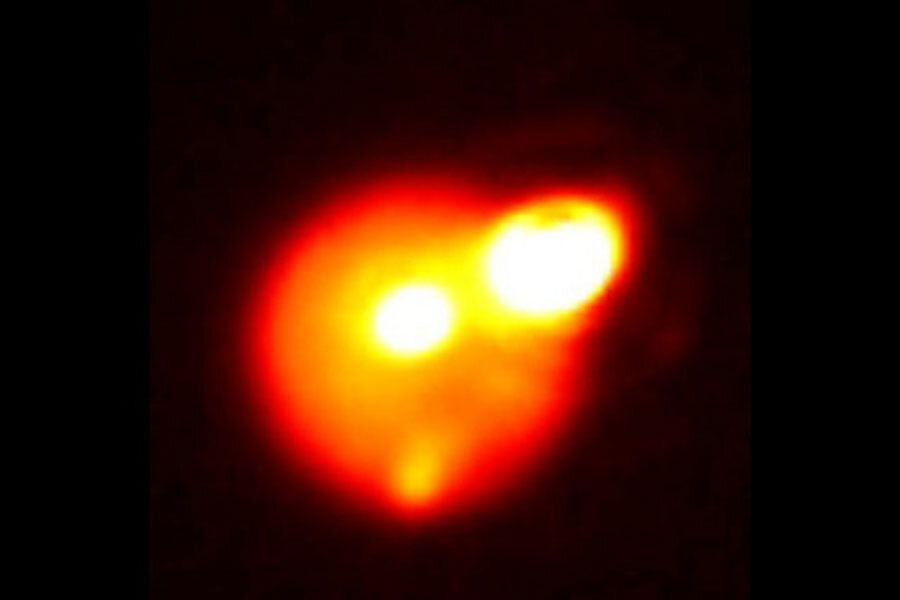Huge volcanic eruptions illuminate Jupiter moon
Loading...
Stunning new photos have captured some of the most powerful volcanic eruptions ever observed beyond Earth, revealing a hellish environment on Jupiter's active "pizza moon" Io.
Astronomers imaged three monster eruptions on Jupiter's volcanic moon Io over a two-week span in August 2013, and released the photos Monday (Aug. 4). The frequency of the blasts surprised researchers, who had recorded just 13 giant Io eruptions from 1978 to 2006.
"We typically expect one huge outburst every one or two years, and they're usually not this bright," Imke de Pater of the University of California, Berkeley, lead author of one of two new studies describing the blasts, said in a statement. "Here we had three extremely bright outbursts, which suggest that if we looked more frequently we might see many more of them on Io." [Jupiter Moon's Volcanic Plume Seen By Spacecraft (Video)]
At 2,300 miles (3,630 kilometers) wide, Io is about the same size as Earth's moon. In the past, scientists have referred to Io as a "pizza moon" because the volcanoes dotting its surface give it a pockmarked look.
The gravitational influence of Jupiter and several neighboring moons pull hard on Io, heating up its insides and setting the stage for the satellite's impressive and unusual volcanism. (While some moons in the outer solar system feature frigid "cryovolcanoes," Io is the is the only solar system body besides Earth known to feature volcanoes of hot, molten rock.)
Two of the big eruptions occurred on Aug. 15, 2013, while the third — and most powerful — took place on Aug. 29. Researchers spotted and studied the blasts using a variety of instruments in Hawaii, including the Keck II and Gemini North telescopes and NASA's Infrared Telescope Facility.
The researchers determined that one of the Aug. 15 outbursts generated lava flows that covered 120 square miles (310 square km), while the other one produced a 50-square-mile (130 square km) flow that was about 30 feet (9 meters) deep. The Aug. 29 blast, meanwhile, was one of the brightest ever observed on Io, scientists said.
All three eruptions can be likened to "curtains of fire," NASA officials said, because they likely blasted out of cracks in Io's surface several miles long.
"These new events are in a relatively rare class of eruptions on Io because of their size and astonishingly high thermal emission," said study co-author Ashley Davies, ofNASA’s Jet Propulsion Laboratory in Pasadena, California. "The amount of energy being emitted by these eruptions implies lava fountains gushing out of fissures at a very large volume per second, forming lava flows that quickly spread over the surface of Io."
While the new observations are helping scientists better understand Io, they should have broader applications as well. After all, extreme volcanism shaped the surfaces of Earth and Venus during the solar system's early days.
"We are using Io as a volcanic laboratory, where we can look back into the past of the terrestrial planets to get a better understanding of how these large eruptions took place, and how fast and how long they lasted," Davies said.
The two new studies have been accepted for publication in the journal Icarus.
Follow Mike Wall on Twitter @michaeldwall and Google+. Follow us @Spacedotcom, Facebook orGoogle+. Originally published on Space.com.
- Photos: The Galilean Moons of Jupiter
- Volcanoes of Io: Video of 1st Map Ever of Volcanic Jupiter Moon
- Io: Jupiter’s Volcanic Moon – Worst Smell in the Solar System | Video
Copyright 2014 SPACE.com, a TechMediaNetwork company. All rights reserved. This material may not be published, broadcast, rewritten or redistributed.







